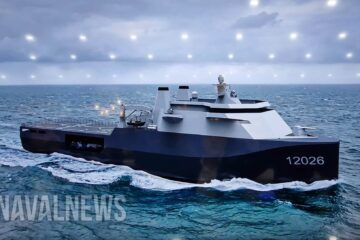Dutch Ministry of Defence Press Release translated by Naval News
These Amphibious Transport Ships are suitable for deployment in war conditions as well as for modern amphibious operations. The vessels can also function as station ships, for example. The first new Amphibious Transport Ship is due to enter service in 2032 and will replace two classes of ships with a single class, State Secretary Christophe van der Maat said to the House of Representatives today.
The navy uses the LPDs (Zr.Ms. Rotterdam and Zr.Ms. Johan de Witt) for amphibious operations: bringing Marine Corps units ashore. The OPVs (Holland-class ships) are mainly designed for tasks low in the violence spectrum.
For instance, they are used to intercept drug shipments in the Caribbean. Although these tasks are quite different, this project combines both classes. In fact, they are converging in terms of needs.

For instance, modern amphibious doctrine calls for light, fast and dispersed operations, with light logistical support. The new generation of ships is therefore smaller in size than the current LPDs. This may result, for example, in multiple Amphibious Transport Ships being deployed simultaneously. OPVs, on the other hand, are not currently designed for tasks high on the violence spectrum. Because of the deteriorating international security situation, the navy needs ships that are suitable for war conditions.
In addition, both classes of ships reach the end of their service life at about the same time. Combining the classes will give the Royal Netherlands Navy more flexibility in designating one or more ships for a given mission. Choosing 1 ship class instead of 2 increases efficiency. It also ensures economies of scale in procurement, training and maintenance, among other things.

As recently reported in the acquisition of the Air Defence and Command Frigates, Defence is also involving Dutch industry in this project. This is done through the Maritime Manufacturing Industry, among others. One of the partners is Damen Naval. Dutch knowledge institutes such as Netherlands Organisation for Applied Scientific Research (TNO), Netherlands Aerospace Centre (NLR) and Maritime Research Institute Netherlands (MARIN) can also contribute.
Collaboration with the United Kingdom
There is also close cooperation with Britain. Dutch and British marines have been pulling together in the UK/NL Amphibious Force for over 50 years. Although the two countries are not acquiring identical ships, they do want to have the same subsystems.

This should enhance mutual cooperation. This could include joint procurement of components such as cranes, lifting equipment and the dock door at the rear of the ship. Acquisition will also involve helicopter installations, propulsion systems and modular systems for accommodation.
Ships to enter service annually from 2032
The inflow of the new Amphibious Transport ships and the outflow of the current 2 LPDs and 4 OPVs will be aligned. A vessel will only be withdrawn from service once a new vessel enters service. From 2032 onwards, a new vessel should be operationally deployable every year.

According to the current schedule, that applies to the last acquisition in 2038. For the Rotterdam, that is actually just too late. The ship reaches the end of its service life as early as 2028. Defence is therefore looking at what measures are needed to keep the ship in service until at least 2032. The outflow of the other ships roughly corresponds to the end of their service life.
The project is estimated to cost between €1 billion and €2.5 billion.






